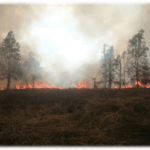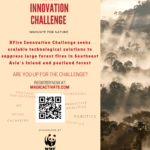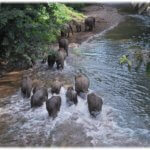
Forest fire and the resulting haze has become an almost annual event in some parts of Southeast Asia. The haze that covered much of Southeast Asia in 2015 was the worst in recent years. A total of 2.6 million hectares of forest, peat and other land were burnt. The World Bank estimated the total economic costs in Indonesia alone exceed US $16 billion. In 2015, these fires were estimated to add 1.6 gigaton of greenhouse gases emitted to the atmosphere.

Unlike some temperate forests where fire is a natural and important part of its ecology, rainforest in Southeast Asia has a “fire shield” – the closed canopy, which ensures high humidity and soil moisture. The “fire shield” is lost when the forest is degraded due to logging, conversion, fires and other forms of disturbance. In a forest with open canopy, fuel and oxygen become available. Once burning starts, wind will quickly spread the fire to adjacent areas. Consequently, fires get out of control. When this happens, the best hope is the monsoon rain, which may be weeks or months away.
Despite effort in raising awareness and capacity building for prevention, early detection and initial attack to suppress fire, these fires escape control, especially in inaccessible terrain.

In hope of reducing the catastrophic impact of forest fire, WWF-Malaysia in collaboration with Malaysian Global Innovation & Creativity Centre (MaGIC), Sabah State Forestry Department (SFD) and the Institute Of Tropical Forestry And Forest Products (INTROP) is organizing a prize challenge called the XFire Innovation Challenge.
The Challenge seeks scalable technological solutions to suppress large wildfires in Southeast Asia’s inland and peatland forest. The winning team will transform firefighting in remote forests with solutions that can be deployed from a permanent or mobile base to a distance of 50 km within four hours in bad air quality, and suppress an uncontrollable fire in 48 hours. The XFire Challenge seeks to reduce deforestation, carbon emission, respiratory health issues and economic loss caused by forest fires and resultant haze.
There are two focus areas for the challenge: Inland Forest and Peatland Forest. Participating teams may design for solutions to address either or both focus areas.

The XFire Challenge is hosted on the ACTIVATE platform of the Malaysian Global Innovation & Creativity Centre (MaGIC). It will be conducted in three phases. Phase 1 focuses on a Proof of Concept (ideation) to be submitted by June 30, 2019. In this phase, participants explain the concept, technology, set up and pre-conditions for the innovation in written and video format. Qualified participants from Phase 1 will enter Phase 2: Prototype, where participants will submit technical description and a video showing a prototype to explaining how it works and demonstrate its ease of deployment. Qualified finalists will be selected to proceed to Phase 3: On-site Lab and Testing, which will involve suppressing real fires.
The challenge is now open. Applicants must be 18 or older and can be from an individual, a team, startup or institution. For more details and to participate, visit MagicActivate.com.
References
- https://en.wikipedia.org/wiki/2015_Southeast_Asian_haze
- http://www.worldbank.org/en/news/feature/2015/12/01/indonesias-fire-and-haze-crisis

